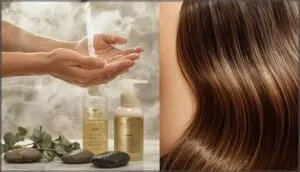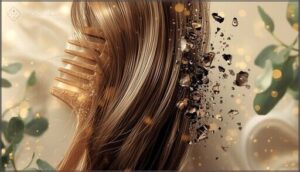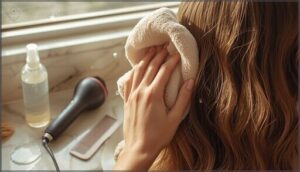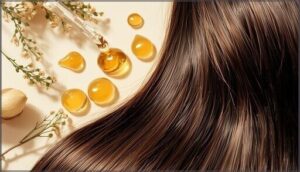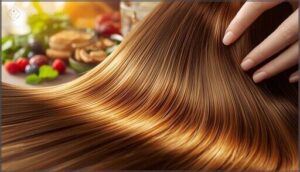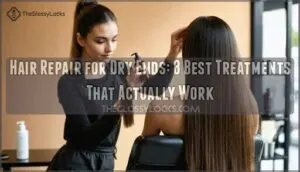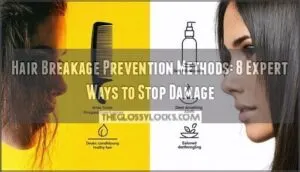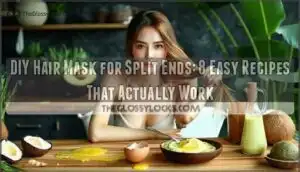This site is supported by our readers. We may earn a commission, at no cost to you, if you purchase through links.
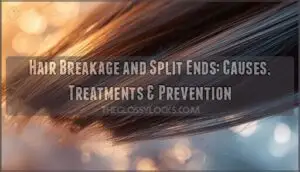 Your hair doesn’t break by accident. Every snapped strand and frayed end tells a story—heat tools cranked too high, chemical treatments stacked too close together, or simple genetics working against you.
Your hair doesn’t break by accident. Every snapped strand and frayed end tells a story—heat tools cranked too high, chemical treatments stacked too close together, or simple genetics working against you.
The damage shows up slowly at first, then all at once when you notice your ends looking thin and ragged despite your best efforts. Hair breakage and split ends aren’t just cosmetic annoyances. They’re signals that something in your routine needs to change.
The good news? Most damage is preventable once you understand what’s actually causing it and which treatments can reverse the harm already done.
Table Of Contents
- Key Takeaways
- Common Causes of Hair Breakage and Split Ends
- Daily Hair Care Tips to Prevent Damage
- Best Treatments for Split Ends and Breakage
- Top 10 Products for Repairing Split Ends
- 1. Oribe Split End Seal Serum
- 2. Davines Nourishing Keratin Sealer Hair Softener
- 3. K18 Leave In Molecular Hair Mask
- 4. Virtue Split End Repair Serum
- 5. Moroccanoil Mending Infusion Hair Serum
- 6. Redken Acidic Bonding Hair Mask
- 7. Maria Nila Structure Repair Leave In
- 8. Living Proof Restore Repair Leave In
- 9. Kerastase Split Ends Hair Repair Serum
- 10. Philip Kingsley Bond Builder Remedy
- Expert Strategies for Long-Term Hair Health
- Frequently Asked Questions (FAQs)
- Conclusion
Key Takeaways
- Heat styling above 356°F and daily chemical treatments destroy up to 85% of your hair’s keratin proteins, making heat protectants and lower temperatures non-negotiable if you want to keep your strands intact.
- Your hair breakage often stems from fixable nutritional gaps—59% of women with hair loss lack sufficient iron, while most people eat less than half the protein their hair needs to build strong keratin structure.
- Clinical-grade serums like Oribe and K18 can seal 90-98% of split ends and restore up to 91% of original hair strength in minutes, but they work best alongside regular trims every 6-8 weeks to stop damage from traveling up the shaft.
- Switching to wide-tooth combs cuts breakage by 40% when detangling wet hair, while satin pillowcases reduce friction overnight—small daily habit changes that compound into visibly stronger hair over months.
Common Causes of Hair Breakage and Split Ends
Your hair doesn’t just break on its own—there’s always a reason behind it. From the tools you use to the nutrients you’re missing, multiple factors can weaken your strands and lead to damage.
Let’s walk through the most common culprits so you know exactly what to watch out for.
Heat Styling and Hot Tools
Among all the culprits behind split ends and breakage, heat styling tools rank near the top. Flat irons and curling wands can damage up to 85% of your hair’s keratin proteins when used above safe thresholds. Here’s what you need to know about heat damage:
- Tools above 356°F cause irreversible structural changes
- Daily styling exposes hair to over 700 heat cycles yearly
- Wet hair begins breaking down at just 320°F
- Chemical-treated hair is especially vulnerable to bubble hair formation
- Heat protectants create a barrier that reduces protein loss
High heat can cause hair cuticle breakdown, leading to brittleness and dryness. Keep your styling temperature under 356°F, and always use a heat protectant before picking up any hot tool.
Chemical Treatments and Hair Coloring
If you color or chemically treat your hair, you’re no stranger to Dye Damage and Bleach Breakage. Hair dye and relaxers weaken strand strength by up to 35%, while perms and color correction can double your risk of split ends.
Color-processed hair often feels dry and brittle, making careful care essential to minimize hair coloring damage and relaxer risks. Heat styling can also cause damage, so it’s important to consider heat damage prevention.
Environmental Factors and Weather
Your hair faces a daily battle with environmental factors you can’t always control. UV radiation strips away protein and weakens strands, while air pollution clogs your cuticle and causes thinning.
Humidity effects trigger frizz and breakage, especially in Atlanta’s 68% average moisture. Temperature extremes crack cuticles through constant expansion and contraction.
When combined, this synergistic damage accelerates split ends and hair breakage faster than any single factor alone.
Nutritional Deficiencies and Diet
While weather wreaks havoc on your strands, what you eat matters just as much. Iron deficiency affects up to 59% of women with hair loss, while vitamin D shortages disrupt follicle cycles. Your protein intake builds keratin structure—68% of people eat less than half the recommended amount. Biotin benefits include thicker, stronger hair. Skip the alcohol; it consistently worsens breakage. Nutrients fuel healthy hair diet from within.
Stress and Underlying Medical Conditions
When stress floods your system, telogen effluvium can push 70% of your hair into shedding mode within three months. Thyroid hair thinning affects up to 50% of people with thyroid disorders, while autoimmune hair damage from lupus impacts half of those diagnosed. Eating disorders starve follicles of nutrients. Trichorrhexis nodosa creates weak points that snap easily.
The psychological impact deepens as medical conditions and hair loss feed each other.
Hair Type and Genetics
Your genetic blueprint determines hair texture, cuticle layers, and strand diameter—all shaping breakage risk. Ethnic hair variations matter: Afro-textured hair breaks roughly ten times faster under combing stress than straight hair.
Fiber breakage risk climbs with tightly coiled structures that bend sharply along the shaft. Genetic hair disorders like monilethrix increase fragility, while hereditary hair loss affects up to 80% of people with noticeable thinning.
Daily Hair Care Tips to Prevent Damage
Your daily routine makes all the difference for preventing breakage and split ends. Small changes in how you wash, condition, and handle your hair can protect it from unnecessary damage.
Let’s walk through the key habits that will keep your hair strong and healthy.
Gentle Hair Washing and Conditioning Routines
How you wash and condition your hair can make or break its health. Here are four hair care tips for a gentle routine:
- Adjust water temperature: Use lukewarm or cool water to protect the hair cuticle and prevent breakage.
- Choose sulfate-free shampoos: These preserve natural oils and reduce dryness.
- Wash 5–6 times weekly: This frequency balances cleanliness without causing damage.
- Always condition: Conditioning benefits include smoother strands and stronger hair fibers.
Proper Use of Shampoo and Conditioner
Think of shampoo and conditioner as a duo that only works when you use them right. Focus shampoo on your scalp to cleanse buildup, then apply conditioner from ears downward—never on the scalp. Leave it on for at least three minutes for real absorption.
When hair care routine basics are ignored, you risk excess oil, breakage, and frizz that even the best products can’t fix.
Benefits of Using Wide-tooth Combs
Your regular brush might be sabotaging your hair health without you even knowing it. Wide-tooth combs cut breakage by up to 40% when detangling wet hair, making them essential for preventing damage and preserving length.
Here’s why they work:
- Reduces Breakage: Wide-tooth combs decrease mechanical stress during hair brushing, resulting in 30% less hair shed
- Gentle Detangling: They require 44% fewer passes through hair compared to traditional hair brushing techniques
- Prevents Damage: Split ends formation drops by 50% with proper use on all hair types
- Scalp Health: Gentle teeth stimulate blood flow, supporting follicle nourishment and growth
Best Practices for Drying and Detangling
How you dry and detangle your hair directly impacts hair breakage and split ends. Start with gentle towel-drying techniques—blot gently with a microfiber towel instead of rubbing, which can increase damage by 25%.
For blow-drying methods, keep the dryer 6 inches away and use a heat protectant to reduce protein loss.
When detangling, work from ends upward with a detangler to cut breakage by 30%.
Choosing Protective Hairstyles and Accessories
Beyond drying and detangling, your choice of hairstyles and accessories plays a major role in hair breakage prevention. Protective styles like knotless braids lower tension and reduce breakage, while poorly chosen hair ties can snap strands.
Here’s how to make smarter selections:
- Style Tension Risks: Avoid overly tight styles that increase traction alopecia
- Material Impact: Use silk or satin scrunchies instead of metal hair accessories
- Knotless Benefits: These braids decrease edge stress considerably
- Maintenance Challenges: Remove protective styles regularly to prevent tangling buildup
Choose lightweight, fabric-covered hair ties for everyday hair styling techniques.
Best Treatments for Split Ends and Breakage
You can’t glue split ends back together, but you can manage them and prevent new ones from forming.
The right combination of treatments will strengthen your hair, seal damaged ends temporarily, and reduce future breakage.
Let’s look at the most effective approaches that actually work.
Importance of Regular Trims
When you skip hair trims, split ends travel up the shaft and cause breakage that steals your length. Cutting split ends every six to eight weeks reduces breakage by up to 35%, giving you better length retention and shape maintenance.
You’ll also notice a manageability boost—your hair tangles less and styles easier.
Plus, trimming promotes scalp health and creates the right environment for growth support.
Deep Conditioning and Hair Masks
Deep conditioning once a week gives damaged or color-treated hair the moisture boost it needs to reduce split ends and hair breakage.
Hair masks with low molecular weight keratin peptides penetrate your hair cortex, increasing fiber strength by 11% and cutting structural irregularities by 30%.
Start with monthly application protocols if you’re new, then work up to weekly treatments to avoid product buildup.
Leave-in Conditioners and Serums
Leave-in conditioners and hair serums work differently than rinse-off treatments—they stay on your hair, continuously sealing split ends and preventing hair breakage throughout the day. Clinical tests show some split-end treatments seal 100% of damage after just two applications, with specially formulated serums boosting moisture by five times.
- Apply leave-in products to damp hair, focusing on mid-lengths and ends
- Choose formulas with pea protein or biomimetic lipids for stronger strands
- Professional stylists increasingly rely on leave-in serums for client satisfaction
- The global leave-in conditioner market reflects growing demand, reaching $2.93 billion in 2025
Effective Ingredients for Repairing Split Ends
When you’re repairing split ends, certain ingredients outperform others in clinical tests. Cuticle-bonding polymers and polyelectrolyte complexes seal damage that lasts through multiple washes—some formulas achieve 90% repair rates.
Ceramides restore moisture and strengthen your hair’s protective barrier, while fatty acid oils like coconut reduce protein loss by 39%.
Adhesive microgels penetrate cracks and create lasting bonds, giving you smoother, healthier-looking ends.
Minimizing Heat and Mechanical Stress
To reduce heat damage and hair breakage, you’ll need smarter strategies with your hair styling tools. Keep heat tool temperature under 365°F—anything higher converts keratin and weakens strands permanently.
- Use heat protectants before any heated styling session
- Switch to wide-tooth combs for gentler detangling methods
- Space out heat sessions and air-dry when possible
- Choose loose protective hairstyles and avoid tight hair ties
Top 10 Products for Repairing Split Ends
You’ve learned what causes split ends and how to prevent them, but sometimes your hair needs extra help.
The right product can seal damaged ends, strengthen weak strands, and stop breakage before it gets worse.
Here are ten professional-grade treatments that actually deliver results.
1. Oribe Split End Seal Serum
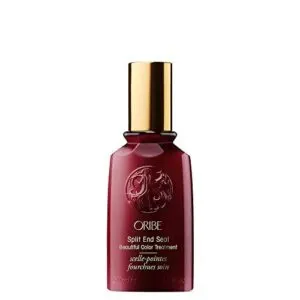
If you’re serious about tackling split ends, Oribe Split End Seal Serum delivers real clinical efficacy—it repairs up to 94% of split ends in one use and cuts hair breakage by 65%. The ingredient performance stands out with watermelon, lychee, and edelweiss extracts protecting against damage, while carob tree extract strengthens each strand.
For usage, smooth this lightweight hair serum onto damp or dry hair before styling. Safety data confirms it’s vegan, paraben-free, and suitable for all hair types.
Market reception? Over 90% of users see visible improvement immediately.
Best For: Anyone with damaged, color-treated, or heat-styled hair looking for a clinically proven serum that repairs split ends, reduces breakage, and adds shine without weighing hair down.
- Clinically proven to repair up to 94% of split ends after just one application and reduce breakage by 65%
- Clean, vegan formula with powerful natural extracts like watermelon, lychee, and edelweiss that protect against damage while adding shine
- Works on both wet and dry hair, provides heat protection, and is safe for color-treated and keratin-treated hair
- At around $50 for 1.7 oz, it’s a premium price point that may not fit every budget
- Some users report it doesn’t completely seal split ends or provide long-lasting results
- The small bottle size means you’ll go through it quickly if you have long or thick hair
2. Davines Nourishing Keratin Sealer Hair Softener
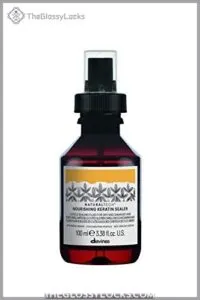
Davines Nourishing Keratin Sealer works like a protective shield for damaged strands. Its vegetal keratin and amino acids smooth the cuticle and reinforce weak spots where split ends start. You’ll apply it to towel-dried hair without rinsing, and the Biacidic Bond Complex seals everything in place.
Ingredient analysis shows this hair treatment cuts breakage by up to 30% with regular use. Customer reviews praise the immediate softness and frizz control, though some note the $40 price point.
For hair repair that lasts through multiple washes, these Keratin Sealer benefits deliver real results.
Best For: People with damaged, dry, or chemically treated hair who want to prevent split ends and reduce breakage without adding extra steps to their routine.
- Seals the cuticle and reduces breakage by up to 30% with regular use, making it effective for strengthening weak, damaged strands.
- No rinsing required—just apply to towel-dried hair and you’re done, which saves time and keeps the protective benefits locked in.
- Works on all hair types and provides immediate softness, frizz control, and shine that lasts through multiple washes.
- Expensive at $40, which might not fit everyone’s budget for a leave-in treatment.
- The scent doesn’t work for everyone—some customers find it unpleasant or too strong.
- Results vary by hair type, with some users reporting dryness or straw-like texture instead of the promised smoothness.
3. K18 Leave In Molecular Hair Mask
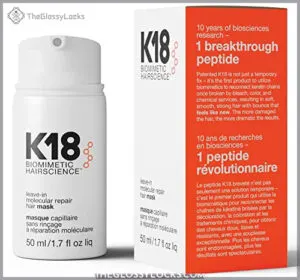
K18 Leave In Molecular Hair Mask targets hair breakage at its source with patented peptide hair repair technology. Clinical study results show it restores up to 91% of original hair strength in just four minutes, making it a powerhouse for split ends and severe damage.
You’ll apply this leave-in treatment to towel-dried hair without rinsing, following a simple application protocol for best absorption.
Though priced at $75, its market impact speaks volumes—with 4.7 out of 5 stars from thousands of reviews and sustainable creation backed by biomimetic science.
Best For: Anyone with chemically treated, bleached, or heat-damaged hair who wants professional-level repair without the salon price tag.
- Restores up to 91% of hair strength in just 4 minutes with clinically proven peptide technology that actually repairs at the molecular level instead of just coating hair.
- Works as a simple leave-in treatment that you don’t rinse out, making it easy to use and long-lasting since you only need a pump or two per application.
- Backed by real science with peer-reviewed research and over 8,000 verified reviews averaging 4.7 stars, so you know it actually works.
- The $75 price tag is steep for a 50mL bottle, even though it lasts a while due to the small amount needed per use.
- May not deliver dramatic results if your hair is already healthy or non-porous since it’s designed specifically for damaged hair.
- Requires a 4-minute wait time before styling, which can be annoying if you’re in a rush.
4. Virtue Split End Repair Serum
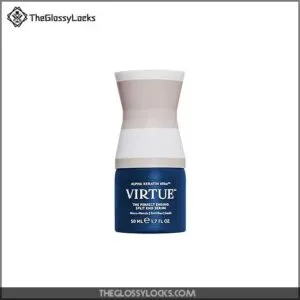
Virtue Split End Repair Serum delivers impressive clinical performance with keratin technology that repairs 98% of split ends after just one use. The formula features Alpha Keratin 60ku, which rebuilds broken hair bonds and cuts hair breakage in half.
Application results show you’ll notice smoother, healthier hair within a week—87% of users reported visible improvements. Consumer reviews give it 4.3 stars, praising its lightweight feel and effectiveness on color-treated hair.
Its safety profile includes a vegan, hypoallergenic formula free from parabens and sulfates.
Best For: People with damaged, color-treated, or chemically processed hair looking for a clinically proven serum that repairs split ends and reduces breakage without heavy buildup.
- Expensive for a small 2.4-ounce bottle, which some customers feel doesn’t justify the price point.
- Mixed reviews on frizz control and effectiveness, with some users reporting sticky residue or minimal improvement.
- Small bottle size means frequent repurchasing for regular users, adding to the overall cost over time.
- Repairs 98% of split ends after one use and cuts breakage in half, backed by clinical studies and a patented keratin protein identical to human hair.
- Lightweight, vegan formula that’s free from parabens, sulfates, and other harsh chemicals—safe for daily use on all hair types including color-treated hair.
- Fast visible results with 87% of users reporting healthier hair within a week, plus it works on both damp and dry hair.
5. Moroccanoil Mending Infusion Hair Serum
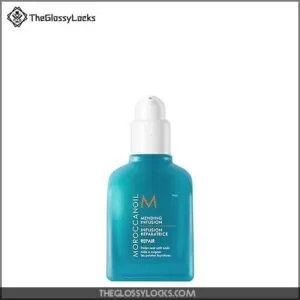
Moroccanoil Mending Infusion Hair Serum uses argan oil benefits and larch tree extract to tackle split ends head-on. You’ll see it seal up to 90% of split-end damage instantly—some tests show 100% improvement on frays under 3mm.
The formula includes baobab and macadamia oils for strength, plus coconut alkanes that lock in moisture and fight frizz.
Application techniques are simple: use a dime-sized amount on dry hair. User satisfaction stays high, with over 90% reporting healthier-looking hair after two weeks of consistent use.
Best For: Anyone dealing with split ends, frizz, or damaged hair who wants a lightweight serum that works fast and doesn’t weigh hair down.
- Some people find it feels sticky or too oily, especially if they use more than the recommended amount.
- The strong scent can be overwhelming if you’re sensitive to fragrances.
- It’s on the pricier side, and opinions are mixed on whether it’s worth the cost for long-term use.
- Seals up to 90% of split ends instantly with argan oil and larch tree extract, giving you smoother, healthier-looking hair right away.
- Works on all hair types without leaving greasy residue—just a dime-sized amount keeps frizz under control and adds shine.
- Over 90% of users report visible improvement in just two weeks, plus it’s cruelty-free and free of parabens and sulfates.
6. Redken Acidic Bonding Hair Mask
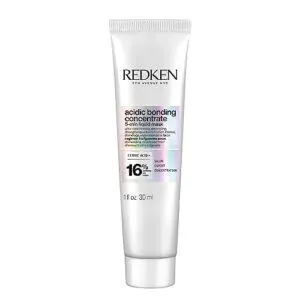
Redken’s Acidic Bonding Hair Mask delivers impressive clinical breakage reduction—63% fewer snaps when used with the full regimen. The Bonding Care Complex, centered on citric acid, focuses on bond repair and works to seal split ends by 82% in manufacturer trials.
Consumer satisfaction runs above 90%, with users noting 14 times better detangling and softer hair. Application frequency matters: aim for weekly use, leaving it on for 5 to 10 minutes.
Ingredient analysis shows it’s vegan and sulfate-free, delivering 72 hours of hydration to reverse hair damage fast.
Best For: Anyone dealing with damaged, brittle, or color-treated hair who wants fast repair and smoother, stronger strands without stripping color.
- The price point is steep for a small bottle, and some users feel it’s not worth the cost compared to other deep conditioning masks.
- A few people report increased frizz or dullness with long-term use, especially in humid weather.
- The scent isn’t for everyone, and if you layer it with other oil-based products, your hair might end up feeling greasy.
- Clinical results show 63% less breakage and 82% fewer split ends when used with the full system, plus hair becomes noticeably softer and easier to detangle.
- The vegan, sulfate-free formula delivers 72 hours of hydration and works quickly—you can see improvement after just one 5-10 minute treatment.
- Safe for all hair types including color-treated hair, and the citric acid helps balance pH while protecting against heat and chemical damage.
7. Maria Nila Structure Repair Leave In
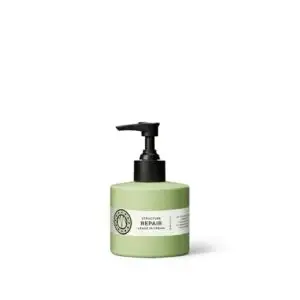
If you’re looking for vegan hair repair backed by clinical trial results, Maria Nila’s Structure Repair Leave In deserves your attention. This leave-in treatment relies on algae extract benefits to tackle hair breakage and split ends directly—93.9% less breakage and 100% improved hair quality in trials.
You’ll apply a coin-sized amount to towel-dried hair, focusing on mid-lengths and ends. Ethical standards compliance shines here: it’s 100% vegan, cruelty-free, and sulfate-free, making it a solid choice for conscious hair strengthening without compromising application best practices.
Best For: Anyone with chemically treated or damaged hair who wants a vegan, clinically proven leave-in treatment that reduces breakage and seals split ends without sulfates or parabens.
- Higher price point compared to drugstore leave-in treatments, which may not fit every budget
- Some customers reported leakage issues and damaged packaging during shipping
- May cause buildup on fine hair if you use too much product per application
- Clinically backed results with 93.9% reduction in breakage and visible split end repair after consistent use
- 100% vegan and cruelty-free formula with algae extract, wheat protein, and nourishing oils that restore moisture and shine
- Easy daily application on towel-dried hair with no rinsing required, plus it layers well with heat styling tools
8. Living Proof Restore Repair Leave In

Living Proof’s Restore Repair Leave In takes a science-backed approach to hair repair with its patented Healthy Hair Molecule (OFPMA). You’ll see up to 15x stronger hair after one use, with ingredient efficacy that prevents 93% of new split ends from heat styling.
Consumer reviews consistently highlight improved detangling and manageability. Apply 1–2 pumps to damp hair, concentrating on mid-lengths and ends—it won’t weigh down fine hair types.
Cost analysis reveals it’s pricier than drugstore alternatives, but the lightweight formula delivers measurable results for tackling hair breakage and damage.
Best For: People with damaged, dry, or heat-styled hair who want a lightweight leave-in that strengthens strands and prevents split ends without weighing hair down.
- Higher price point compared to drugstore leave-in treatments
- Can feel sticky if applied to completely dry hair instead of damp strands
- Some users report packaging issues with leakage due to missing or faulty product caps
- Strengthens hair up to 15x after just one use and prevents 93% of new split ends caused by styling
- Lightweight formula works for all hair types, even fine hair, and won’t cause buildup with daily use
- Contains vegan ingredients, UV protection, and is safe for color-treated hair
9. Kerastase Split Ends Hair Repair Serum
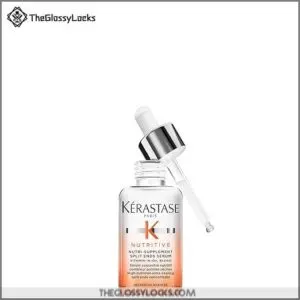
Kérastase’s Nutritive Split Ends Hair Repair Serum delivers impressive efficacy claims—it reduces split ends by two times and boosts hair strength by up to 99% versus unwashed hair. The serum ingredients include plant-based proteins with 17 amino acids and niacinamide to reinforce your hair fiber and prevent breakage.
User feedback confirms noticeable split end treatment results after one month of consistent use. Application protocols recommend 5 drops on wet or dry ends as a leave-in treatment.
Market data places it in the premium hair repair segment at around $45 for 50 mL.
Best For: Anyone dealing with dry, damaged hair and visible split ends who wants a salon-quality treatment that delivers measurable results and doesn’t mind investing in a premium product.
- Pricey at around $45 for just 50 mL, which adds up quickly if you use it daily.
- Won’t completely eliminate split ends—it seals them well but isn’t a miracle cure, so you’ll still need regular trims.
- Best results require consistent use over time, so it’s not a quick fix if you’re looking for instant transformation.
- Backed by solid science—reduces split ends by 2x and increases hair strength by up to 99%, with real user feedback confirming smoother, shinier hair after a month of use.
- Lightweight formula with plant proteins and niacinamide absorbs fast and works on all hair types, from fine to thick and textured.
- Flexible application as a leave-in treatment on wet or dry hair means it fits easily into any routine without extra steps.
10. Philip Kingsley Bond Builder Remedy
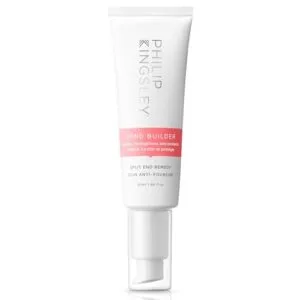
When bond repair products promise results, clinical efficacy matters—and Philip Kingsley’s Bond Builder Remedy delivers. This hair breakage treatment reconnects broken bonds at the molecular level, restoring 84% of your hair’s strength after five applications.
The ingredient analysis reveals panthenol for moisture retention, hydrolyzed oat protein, and biomimetic 18-MEA technology that mimics healthy hair structure.
Your application protocol? Apply to towel-dried hair every third wash, leaving it for 10–20 minutes.
User insights from over 6,000 reviews confirm substantial reduction in split ends and breakage with consistent use.
Best For: Anyone dealing with heat damage, chemical processing, or chronic split ends who wants clinically proven bond repair that actually rebuilds hair strength over time.
- Expensive for what you get, and the small bottle size won’t last long if you have longer or thicker hair
- Requires a 10-20 minute wait time before rinsing, which adds extra steps to your routine
- Won’t permanently eliminate split ends—it seals and improves their appearance, but regular trims are still necessary
- Restores 84% of hair strength after five treatments with advanced bond-rebuilding technology that works at the molecular level
- Contains biomimetic 18-MEA technology and panthenol that mimic healthy hair structure while keeping strands moisturized without heavy buildup
- Over 6,000 user reviews confirm visible reduction in breakage and split ends with consistent use every third wash
Expert Strategies for Long-Term Hair Health
Taking care of your hair isn’t just about the products you use or how often you trim. Real, lasting hair health comes from looking at the bigger picture—what you eat, how you manage stress, and whether your routine actually fits your hair type.
Let’s walk through five expert strategies that’ll help you build stronger, healthier hair from the inside out.
Maintaining a Balanced, Nutrient-rich Diet
Your hair needs more than good products—it thrives on what you eat. A healthy diet rich in protein keeps strands strong, while iron sources like red meat and leafy greens support growth.
Don’t overlook vitamin deficiencies; vitamins D and C reduce shedding. Healthy fats from salmon and walnuts lock in moisture, and folate benefits include stronger follicles.
Prioritize hair nutrition, and you’ll see the role of diet in hair health reflected in every strand.
Managing Stress for Healthier Hair
Stress doesn’t just weigh on your mind—it triggers cortisol reduction challenges that directly impact hair health. When you’re overwhelmed, stress biomarkers like elevated cortisol levels push follicles into rest mode, causing hair shedding and breakage.
Prioritize mental wellness through yoga or meditation to improve scalp circulation. Comprehensive approaches that calm your nervous system protect against hair loss while strengthening every strand from within.
Identifying and Addressing Medical Causes
Sometimes the answer isn’t in your bathroom cabinet—it’s in your bloodwork. Thyroid disorders like hypothyroidism affect up to 2% of people and disrupt hair growth cycles, causing breakage. Iron deficiency impacts nearly 28% of women with hair loss, while autoimmune diseases and medication-induced damage weaken strands from within.
If you’re experiencing persistent breakage despite good hair care, ask your doctor about testing for these underlying conditions.
Adapting Care for Hair Type and Texture
Your hair’s unique blueprint—shaped by genetic factors—demands a custom approach. Understanding your hair texture and hair porosity helps you choose the right treatments.
Fine hair breaks 44% more easily under stress, so lightweight protein products work best. Curly hair types face 30% higher breakage rates because natural oils can’t reach the ends.
Protective styling reduces breakage by 28% in textured hair, while wide-tooth combs cut damage by 20%.
Scheduling Regular Professional Trims
Beyond choosing the right products, your trim schedule plays a powerful role in length retention and damage reduction. Most experts recommend haircuts every 6–8 weeks to keep split ends from traveling upward.
Here’s what regular hair trimming and split ends prevention delivers:
- Up to 50% fewer split ends
- Better styling outcomes with less frizz
- Economic benefits from avoiding costly repair treatments
- Stronger hair care for split ends overall
Even a quarter-inch trim preserves length better than skipping appointments entirely.
Frequently Asked Questions (FAQs)
Can split ends travel up the hair shaft?
Think of a split end like a crack in glass—once it starts, it keeps climbing. Through cuticle damage and cortex exposure, the fracture spreads upward from mechanical stress, driven by damage mechanics along the hair shaft.
Does brushing hair 100 strokes daily help or harm?
Brushing hair 100 strokes daily causes more harm than good. This old-fashioned habit increases hair breakage and split ends through mechanical stress.
Instead, gentle brushing twice daily distributes oils without damaging your strands.
How does water hardness affect hair breakage?
Hard water deposits calcium and magnesium on your hair, creating mineral buildup that increases hair roughness and cuticle damage.
This reduces tensile strength and moisture retention, making breakage more likely over time.
Are satin pillowcases effective for preventing damage?
Like a gentle breeze against your hair, satin pillowcases—with a low friction coefficient—protect hairstyle integrity, reduce breakage, and retain moisture.
Compared to cotton pillowcases, expert recommendations favor satin or silk for best hair health and split ends prevention.
Can hair breakage be reversed without cutting?
Hair breakage can’t be biologically reversed—damaged hair is dead tissue. However, protein treatments and serums offer temporary sealing and cosmetic improvements.
Expert consensus confirms preventative measures work best; regular trims remain essential for hair repair.
Conclusion
Think of your hair like a garden—neglect it, and weeds take over. Treat it right, and it flourishes. Hair breakage and split ends don’t appear overnight, but neither does recovery.
The routines you build today determine what you see in the mirror six months from now. Start with one change: a weekly mask, gentler detangling, or regular trims.
Small shifts compound into stronger, healthier strands that actually last.
- https://xray.greyb.com/cosmetics/hair-split-end-prevention
- https://www.yahoo.com/news/the-difference-between-hair-fall-from-the-root-and-hair-breakage.html
- https://pubmed.ncbi.nlm.nih.gov/26207659/
- https://www.forhers.com/blog/what-are-split-ends
- https://miamihair.com/blog/7-shocking-stats-about-hair-loss/

